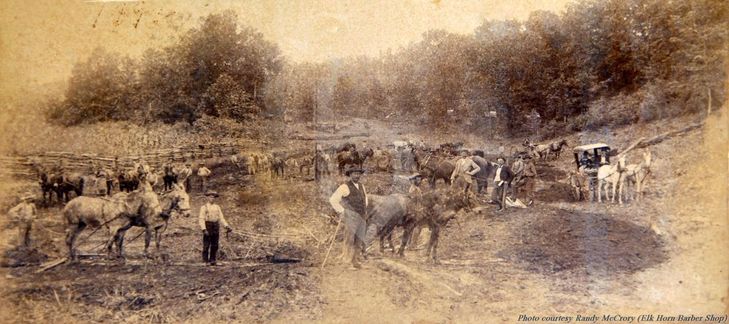The Bentonville Railroad and Frisco's Bentonville Branch
By Tom Duggan
By Tom Duggan
From the first day of operation in 1883, there was a desire to link the Bentonville Railroad with a railroad other than the Frisco at Rogers. An alternate link would assure Bentonville of competitive freight rates and access to new markets. This well-founded business desire would create repeated disappointments and financial losses due to Bentonville's repeated involvement with railroad confidence men. In early 1888, the Bentonville Democrat announced that construction of the Kansas City & Sabine Pass Railroad was certain. Bentonville stood directly on the route of the new line. A week later the same weekly paper trumpeted the proposed Central Kansas & Arkansas line from St. Joseph, Missouri to Van Buren, Arkansas. Bentonville again would be on the route of the second new line. A week later, the Democrat denounced the Kansas City & Sabine Pass project as a swindle after having run an article speculating about Bentonville's role as a railroad center.
In December 1888, representatives of Bentonville, Jane, Missouri, and Pineville, Missouri met with Col. Bush of the Kansas City, Fort Smith, and Southern Railroad (the "Splitlog Line") in Neosho, Missouri. This line was in operation from Joplin, Missouri to Splitlog, Missouri (west of Anderson, Missouri). Matthias Splitlog, a wealth Wyandotte Indian of French-Canadian origin and Kansas City area landowner, built the railroad to tap the traffic anticipated from the Southwest Missouri silver boom. Unfortunately, there were no commercial silver deposits in the area. Financially strapped Matthias Splitlog soon sold his railroad to Philadelphia investors. Bentonville was elated, as the Splitlog's southern end was only 35 miles distant. To whet local interest the Splitlog Line had its timecard published in weekly Bentonville Democrat.
On New Years Eve 1888, the citizens of Bentonville held a railroad convention to raise about $350 for survey of the 1880 railroad route to Southwest Missouri. Bentonville felt it was a natural choice for an extension of the Splitlog . Residents hoped that the new line extension would reach Bentonville by July 4, 1889 in time for a gigantic celebration. The optimism chilled when newspapers reported the Splitlog was considering a southward extension to Sulphur Springs, Arkansas. a town some seventeen miles to the northwest. By February 1889 both Neosho, Missouri newspapers were speculating that Bentonville would not be on the Splitlog as Bentonville was too close to the Frisco at Rogers.
Col. Samuel W. Peel, Bentonville's leading citizen, visited Philadelphia in May 1889 to plead Bentonville's case with Col. Bush of the Splitlog. Although the citizens of Bentonville had agreed to furnish a subsidy of $50,000, Col. Peel returned home without a commitment to include Bentonville on any southward extension. By late June 1889 the Splitlog had decided to follow a projected route that would involve extending the line to Sulphur Springs, Arkansas and then through western Benton County. A map published by the Splitlog shows the line intended to reach Prairie Grove, Arkansas en route to the commercial center of Fort Smith, Arkansas. Bentonville then sought to have the Splitlog build a branch from Sulphur Springs to Bentonville. The railroad did nothing more than to send a survey crew over the proposed branch line. The loss of the Splitlog connection was embarrassing. The Bentonville Railroad had extended its track one-mile in anticipation of a link to the Splitlog. The Bentonville Railroad was in the strange position of reporting it was a line of 6.25 miles including "one mile not operated." Perhaps the one mile-extension was a factor in the year later 1890 foreclosure and sale of the Bentonville Railroad.
The next trial was the Kansas City, Bentonville, and Southeastern Railway of November 1890. The new line required the now standard $50,000 subsidy. It would run from Bentonville to Rutledge (now Elk Crossing), Missouri with a southern extension to Springdale, Arkansas. The Bentonville Democrat did its part to fan railroad fever. It suggested the Kansas City, Bentonville & Southeastern would make Bentonville the "the Gate City of the northwest" and "railroad center of the South." In July 1891, the line became visible as surveying began and Dr. John Smartt, first President of the Bentonville Railroad, prepared to turn the first shovel of dirt. The Bentonville Democrat of July 2, 1891 printed an interview with a Mr. Schneider, chief surveyor for the Kansas City, Bentonville, & Southeastern, which was highly skeptical of Mr. Schneider and prospects for the line. By late August 1891, the line had graded six miles. Traces of the right of way, including three bridge abutments, are still visible in the area of Hog Slaughter Hollow in Bentonville. Work stopped in early September 1891 without track having been laid. The railroad likely failed as one portion of the line required extensive blasting through rock. The Kansas City, Bentonville & Southeastern was another failure.
In December 1888, representatives of Bentonville, Jane, Missouri, and Pineville, Missouri met with Col. Bush of the Kansas City, Fort Smith, and Southern Railroad (the "Splitlog Line") in Neosho, Missouri. This line was in operation from Joplin, Missouri to Splitlog, Missouri (west of Anderson, Missouri). Matthias Splitlog, a wealth Wyandotte Indian of French-Canadian origin and Kansas City area landowner, built the railroad to tap the traffic anticipated from the Southwest Missouri silver boom. Unfortunately, there were no commercial silver deposits in the area. Financially strapped Matthias Splitlog soon sold his railroad to Philadelphia investors. Bentonville was elated, as the Splitlog's southern end was only 35 miles distant. To whet local interest the Splitlog Line had its timecard published in weekly Bentonville Democrat.
On New Years Eve 1888, the citizens of Bentonville held a railroad convention to raise about $350 for survey of the 1880 railroad route to Southwest Missouri. Bentonville felt it was a natural choice for an extension of the Splitlog . Residents hoped that the new line extension would reach Bentonville by July 4, 1889 in time for a gigantic celebration. The optimism chilled when newspapers reported the Splitlog was considering a southward extension to Sulphur Springs, Arkansas. a town some seventeen miles to the northwest. By February 1889 both Neosho, Missouri newspapers were speculating that Bentonville would not be on the Splitlog as Bentonville was too close to the Frisco at Rogers.
Col. Samuel W. Peel, Bentonville's leading citizen, visited Philadelphia in May 1889 to plead Bentonville's case with Col. Bush of the Splitlog. Although the citizens of Bentonville had agreed to furnish a subsidy of $50,000, Col. Peel returned home without a commitment to include Bentonville on any southward extension. By late June 1889 the Splitlog had decided to follow a projected route that would involve extending the line to Sulphur Springs, Arkansas and then through western Benton County. A map published by the Splitlog shows the line intended to reach Prairie Grove, Arkansas en route to the commercial center of Fort Smith, Arkansas. Bentonville then sought to have the Splitlog build a branch from Sulphur Springs to Bentonville. The railroad did nothing more than to send a survey crew over the proposed branch line. The loss of the Splitlog connection was embarrassing. The Bentonville Railroad had extended its track one-mile in anticipation of a link to the Splitlog. The Bentonville Railroad was in the strange position of reporting it was a line of 6.25 miles including "one mile not operated." Perhaps the one mile-extension was a factor in the year later 1890 foreclosure and sale of the Bentonville Railroad.
The next trial was the Kansas City, Bentonville, and Southeastern Railway of November 1890. The new line required the now standard $50,000 subsidy. It would run from Bentonville to Rutledge (now Elk Crossing), Missouri with a southern extension to Springdale, Arkansas. The Bentonville Democrat did its part to fan railroad fever. It suggested the Kansas City, Bentonville & Southeastern would make Bentonville the "the Gate City of the northwest" and "railroad center of the South." In July 1891, the line became visible as surveying began and Dr. John Smartt, first President of the Bentonville Railroad, prepared to turn the first shovel of dirt. The Bentonville Democrat of July 2, 1891 printed an interview with a Mr. Schneider, chief surveyor for the Kansas City, Bentonville, & Southeastern, which was highly skeptical of Mr. Schneider and prospects for the line. By late August 1891, the line had graded six miles. Traces of the right of way, including three bridge abutments, are still visible in the area of Hog Slaughter Hollow in Bentonville. Work stopped in early September 1891 without track having been laid. The railroad likely failed as one portion of the line required extensive blasting through rock. The Kansas City, Bentonville & Southeastern was another failure.
This image that had once been in the old Elk Horn Barber Shop is believed to be grading for "The Kansas City, Bentonville, and Southeastern Railroad. This line would have gone through the property where Crystal Bridges is located today.
The next railroad event was the May 1892 renewed discussion with Splitlog line. Bentonville's failure to make a deal with Splitlog was unfortunate, The Splitlog later was purchased by the Kansas City, Pittsburg & Gulf, which today operates through western Benton County as the Kansas City Southern Railway.
The year 1895 began with Dr. Smartt chairing another railroad committee. The Arkansas & Northwestern projected a line from Bentonville to Aerie, Kansas (probably an early spelling of Erie, Kansas) on the Missouri-Kansas-Texas Railroad. The second phase contemplated as extension that would link Bentonville to the state capital of Little Rock. The line to Aerie, Kansas planned to connect with the Kansas City, Pittsburg & Gulf that had taken over the Splitlog line in 1893. The financing package for the Arkansas & Northwestern Railway required Bentonville to provide $50,000 in subsidy notes, Gravett. Arkansas (spelled with only one "e" at this time)- $12,000, Southwest City, Missouri- $12,000 and 25,000 railroad ties and Miami, Indian Territory- $15,000. Following several mass meetings, Bentonville raised the $50,000 subscription and finally seemed assured of a non-Frisco connection to Kansas City. On December 26, 1895, work began with five teams of horses and twelve men. The subsidy agreement called for completion in 1897. In early 1898, subscribers received their unused subsidy notes.
Just as Bentonville's Railroad Committee was dealing with the collapse of the Arkansas & Northwestern project, J. Jay Spencer of the Kansas City Terminal Railway met on January 18, 1896 with an officer of the Bentonville Railroad. Spencer, probably an agent of the Kansas City, Pittsburg & Gulf, predicted the Bentonville Railroad would soon collapse. His solution to the collapse was the construction of a new railroad line from Bentonville to Sulphur Springs, Arkansas on the Kansas City, Pittsburg, & Gulf. The second phase envisaged a southern extension to Springdale, Arkansas that would turn eastward to Bald Knob, Arkansas on the St. Louis, Iron Mountain & Southern Railway. Spencer estimated the cost of the initial twenty miles as $88,400. The timing of Spencer's visit was ironic as the last thing Bentonville needed was another railroad project requiring Bentonville capital and civic attention.

